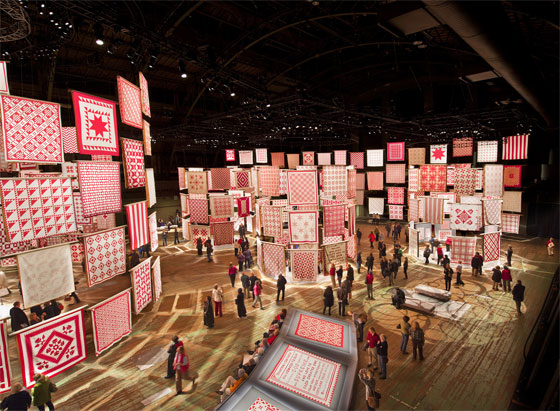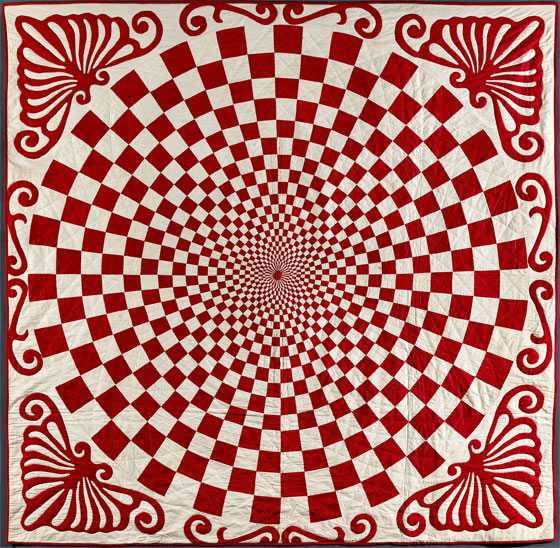
American Folk Art Museum Presents, Infinite Variety: Three Centuries of Red and White Quilts at the Park Avenue Armory, March 25-30, 2011, Installation view. Photo by Gavin Ashworth
Over 650 red and white quilts currently hang from the ceiling of The New York Park Armory. Up for just four days (and closing today), Infinite Variety showcases the vast archive of quilts amassed since 1956 by collector Joanna Rose. It is her 80th birthday wish: “Something I've never seen before,” she told her husband Daniel Rose when he asked what she would like to celebrate, and “a gift for New York”. The show is completely free to the public.
I visited the Park Avenue Armory this Sunday and was so impressed by the cylindrical scaffold towers of quilts and obsessive attention to detail I contacted co-curators Elizabeth V. Warren, guest curator and an a leading authority on quilts, and Stacy C. Hollander, senior curator at the Folk Art Museum. I also got in touch with Tom Hennes at Thinc Design, to discuss the exhibition design. What follows is the first of a two part interview series with Elizabeth V. Warren and Tom Hennes. Today, I speak with Warren.
Paddy Johnson: How long was this show in the making?
Elizabeth V. Warren: About 15 months. A year ago in January Joanna Rose called us and said that she wanted to do an exhibition of her red and white quilts and she wanted to the museum to handle this as their project and we got started then.
PJ: 50 of these quilts that will be donated but there are many more in the show is that right? Of the 50 that will be donated, will they be on display afterwards? What will happen to them?
EW: I have no idea. We haven't set up yet exactly when they will be donated, exactly which quilts they will be, or exactly the final number we'll get, so it's going to be a process. It's not all happening right away.
PJ: Did donation itself spark the show?
EW: No. It was the opportunity to participate in an incredible exhibition and happening and making this all available. I mean, as folk art lovers and quilt lovers and scholars, this is what gets us going, this is what we do. The donation is a nice add-on.
PJ: Your dedication shows — the quilts looks fantastic. I took some of the tours while I was at the show. I recall hearing that stars were one of the hardest forms to make.
EW: Well, so I've been told. I don't quilt myself but that's what I understand. There's a lot of math and a lot of geometry and precision involved especially in star and feather designs. It won't lay flat unless you get it exactly right so that's important to quilters.
PJ: So for you what were some of the highlights of the quilts you were displaying in the show?
EW: Well, as an art historian, part of it was to see how designs change over time. You take a common design like the basket quilt and see how it evolves over time. There's a traditional 19th century pattern, and by the 20th century it gets influenced by Art Nouveau and Art Deco, so there's all kinds of different iterations of it. Also, what was interesting to me was being able to do some of the genealogy, to learn about their lives, place them in history, find out what their lives might have been like. It's a way of going back in history and studying women's lives the same as you might study a painting or sculpture or any other work of art.

Artist unidentified, Vortex quilt United States; 1890-1910 Pieced and appliquéd cotton; 80 x 82" Collection of Joanna S. Rose Photograph by Gavin Ashworth
PJ: At the time a lot of those patterns were made anonymously I recall.
EW: We always say anonymous was a woman. Most of the quilts in the exhibition are what I call orphans. They come in without any provenance, we don't know who made them, when, where, any of that. Sometimes there are quilts that are signed and those are the ones that we can really get our teeth into researching. Others we just have to place in a time period based on the design, the fabric, the colors and that’s a little hard when they are all red and white so we just have to go with what we know about quilt making in the past.
PJ: So are the signatures the main way that you trace genealogy or provenance then?
EW: Absolutely. For example, we have one quilt that's signed “To Charles and Cornelia from your loving mother Lavinia Rose dated 1856, Cortland Ville N.Y. (4:51). I was able to find Lavinia and her family and learn that she was the second wife of Jehiel Rose and she had ten children – none of them were named. There were actually two quilts that are almost exactly alike that were purchased by Mrs. Rose at different times, different places. She didn't know they were related. One is to Charles and Cornelia, one is to Daniel and Amarilla. I found her and the 10 children. None of them were named Charles, Cornelia, Daniel or Amarilla, but by doing the genealogy I found out that she had a daughter named Abigail Cornelia, I believe that that's the Cornelia on the quilt. I think that's what her family called her. And that the son of her husband Jehiel and his first wife was named Daniel, and that that's the Daniel on the Daniel and Amarilla quilt.
PJ: It sounds like this can become very complicated.
EW: It can, but I've had no life. I've spent hours on Ancestry.com and familysearch.com looking at these family trees trying to put it all together.
PJ: And something like Ancestry.com is really helpful to you?
EW: It is. It used to be that I would spend days in the archives down on Varick street. There are still things you can't find online, but you can do a lot of it. Certainly it's addictive and it's a very good way to spend a Saturday if you have nothing else you have to do.
PJ: And did anyone in that woman's family continue to quilt?
EW: You know, I haven't been able to find any members of the family still living. I found Daniel and Amarilla married and living in Virginia in 1890 but I didn't trace them past that. Once I found Daniel and knew that he was Levena's stepson I stopped.
PJ: Of the works you were able to trace, for how many of them were you able to find living family members?
EW: I haven't had time to do that. As I said, this has been a 15 month project.
PJ: Which is a short period of time to launch an exhibition.
EW: Yes, it's very short to put on an exhibition of this magnitude or any magnitude. We hope to have a book out in the next two years and in preparation for that I'll be able to do a lot more research.
PJ: Typically are the quilts the result of one woman's work, or are they often the result of many?
EW: I think it varies. Many were made by women working alone. Very frequently what would happen is that women would piece the quilts themselves they would make the top and then sometimes they would get together at sewing societies or quilting bees or ladies aid societies and do the quilting, you know, the stitching that holds the three layers together. Often they would do that as a group. But really, the most common way was for women to make the quilts themselves. Quilting bees happen, they were an important part of a community, but people think more quilts were made that way then really were. I think that's a very delightful picture and they certainly happened but a lot of them were made by women working alone.
PJ: Is there an average amount of time that someone might spend?
EW: I really have no idea. It could be months depending on how much time a woman had.
PJ: But definitely months.
EW: Yeah. She may have every day to work on the quilt, she may have been a wealthy woman and had servants to do some of the work. You don't know. And consider, too, that so many of these were made by candlelight or firelight. There's only so many hours a woman had free to work on these.
PJ: And is it the case that every quilt in the show is handmade? I mean, I overheard a quilter at the show saying this.
EW: No. Remember, the sewing machine came to be used in the United States in 1848. That was the greatest boon in women’s life and often women in a town would pool their money so they could by a machine and then share it. And talking about those treadle powered sewing machines, still today quilts are pieced by machines. They are probably mostly hand quilted. They weren't machine quilted. It would not be unusual if they were pieced by machine.
PJ: Okay, that makes sense to me. And on the subject of color. This is a red and white themed exhibition and that has something to do with the steadfastness of the color red, is that correct?
EW: Yes. That Turkey red dye was a process that was developed in the — it came to England in the 18th century to dye cotton in Manchester and wool in Scotland. It was particularly colorfast. It was more expensive – it was a week-long process – but quilters liked it because the color would not run into other colors, would not fade, and would not eat into the fabric like so many of the other dyes did. And by the 19th century, there was a synthetic dye that could do that. The process was shorter. It was still a little more expensive than other dyes but for quilt makers it was worth it to know that they could wash their work and that the red would not run into the white. The only other color scheme that was equally as popular is indigo blue and white, for the same reason, because indigo blue was colorfast as well.
PJ: So do you have an indigo blue show in the works?
EW: Only if I find someone who's got a collection like that. I don't know of any, but you never know.


{ 8 comments }
It reminded me of The Infinite Fill Show: http://www.coryarcangel.com/things-i-made/infinitefill/
Good call.
Why do I just hear of this show now. Any chance they might extend it?
thank you so much for highlighting this awesome, awesome show. i am really looking forward to reading about its genius installation.
pls inform us of shows this good b4 they are closing, if you’d be so kind. Thanks!
Yeah, I wish I could have gotten the piece up earlier. But there’s not a lot that can be done when one sees the show Sunday, and is out of the office all day Monday. I turned the interview around in a day, but it still sucks that I could get it out any sooner.
http://farm5.static.flickr.com/4053/4390987550_0174afb244.jpg
I think this show should come to Canada next – more specifically Guelph or Kitchener -Waterloo.
Comments on this entry are closed.
{ 2 trackbacks }